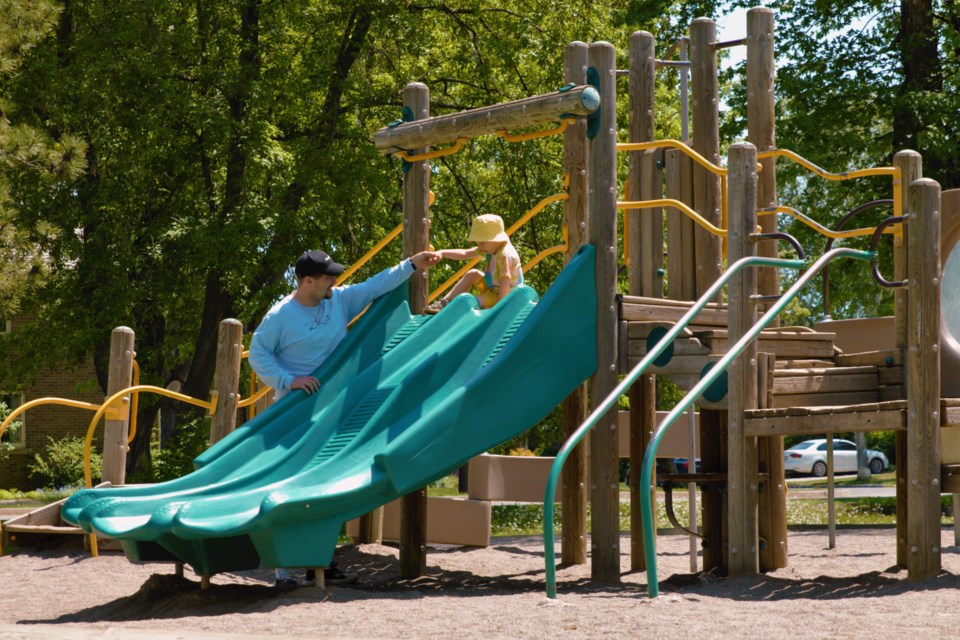THUNDER BAY — Vickers Park is set to become Thunder Bay’s second inclusive play hub when its playgrounds are replaced later this year.
The new design will emphasize accessibility and will be built around both a trees and treehouse theme and an Edwardian theme recognizing the more-than-century-old park’s history.
The city’s call for proposals to design and build the new playground closed this week, and are set to come to city council for review and approval within weeks.
When the playground is completed later this year, it will realize a vision the city set out several years ago to build fully accessible playgrounds in the city’s north and south ends, said parks and open spaces supervisor Werner Schwar.
“I think the key is the ability for kids to interact with kids, not segregation of [play],” he said. “That’s a very important part of the focus, that everyone feels like they can belong and participate at whatever level they’re at, whether that’s cognitive [or] physical abilities.”
The city took its first step in that direction with the opening of new equipment at Boulevard Lake last year that focuses heavily on supporting participation by residents of all ages and abilities.
That was accomplished with features like a poured rubber surface, double-wide ramps, accessible swings, and zones for sensory play.
The positive public reaction to the park affirmed that approach is appreciated by all, not just those with disabilities, said Schwar.
“When you go there on an early Saturday morning … and there’s hundreds of people there, whether they’re on the structure or are doing other things, that’s so good to see,” he said.
“The old structure at Boulevard was used, but I don’t think in the same way. It had limited options for different activities for kids, and it wasn’t inclusive at all.”
The Vickers Park playground won’t achieve quite the same scale as the one at Boulevard, which got a boost from a $750,000 sponsorship, Schwar said.
Still, with a budget of up to $1.1 million, he expects it to similarly impress local users with new features and approaches.
“That is the hope,” he said. “[It] is a lot more budget than we normally spend on a small neighbourhood park. In theory, it should be two or three times the play value of what’s in a normal park.”
“It’s not just a playground in a park anymore, it really is a community hub, so to speak.”
More than one third of the budget could be eaten up by the rubber surfacing, which Schwar called the “gold standard” for inclusive playgrounds, replacing the current sand surfaces that can no longer be built under the Accessibility for Ontarians with Disabilities Act.
The proposed designs for a Vickers playground will be reviewed by the city’s accessibility and heritage advisory committees.
While companies will have wide leeway to pitch their own design ideas, the city’s request for proposals directs them to focus on accessibility and inclusive play and include features like swings and slides based on public feedback.
It also prohibits the removal of trees, and asks proponents to consider a central shaded seating area.
While public feedback showed a strong desire for an on-site washroom, that is not included in the RFP, though it does mention an intention to add a self-cleaning toilet in the future.
The playground area could be relocated, but will remain on the park’s east side.
The city also asked contractors to address “crime prevention through environmental design,” which Schwar said would involve issues like visibility from surrounding streets into Vickers Park.
Public consultations held between 2019 and 2021 supported both the “tree/treefort” theme and the use of natural materials in the park’s design.
The city’s heritage committee, meanwhile, requested that “the overall context of the Edwardian historical era is also to be explored” in the park’s theme.
Only 13 per cent of those who provided public feedback said they wanted a historical theme, compared to 54 per cent who favoured a trees/treefort theme.
The committee designated Vickers Park as a heritage property last year.
The 10-hectare park was donated to the town of Fort William in 1902 by Catherine Mary Vickers to honour her late husband, John Vickers, and two other Fort William founders, John McIntyre and John McKellar.
Play features like swings, slides, and sandboxes were added in 1949.
The play equipment was last updated in 1985, the city says.
